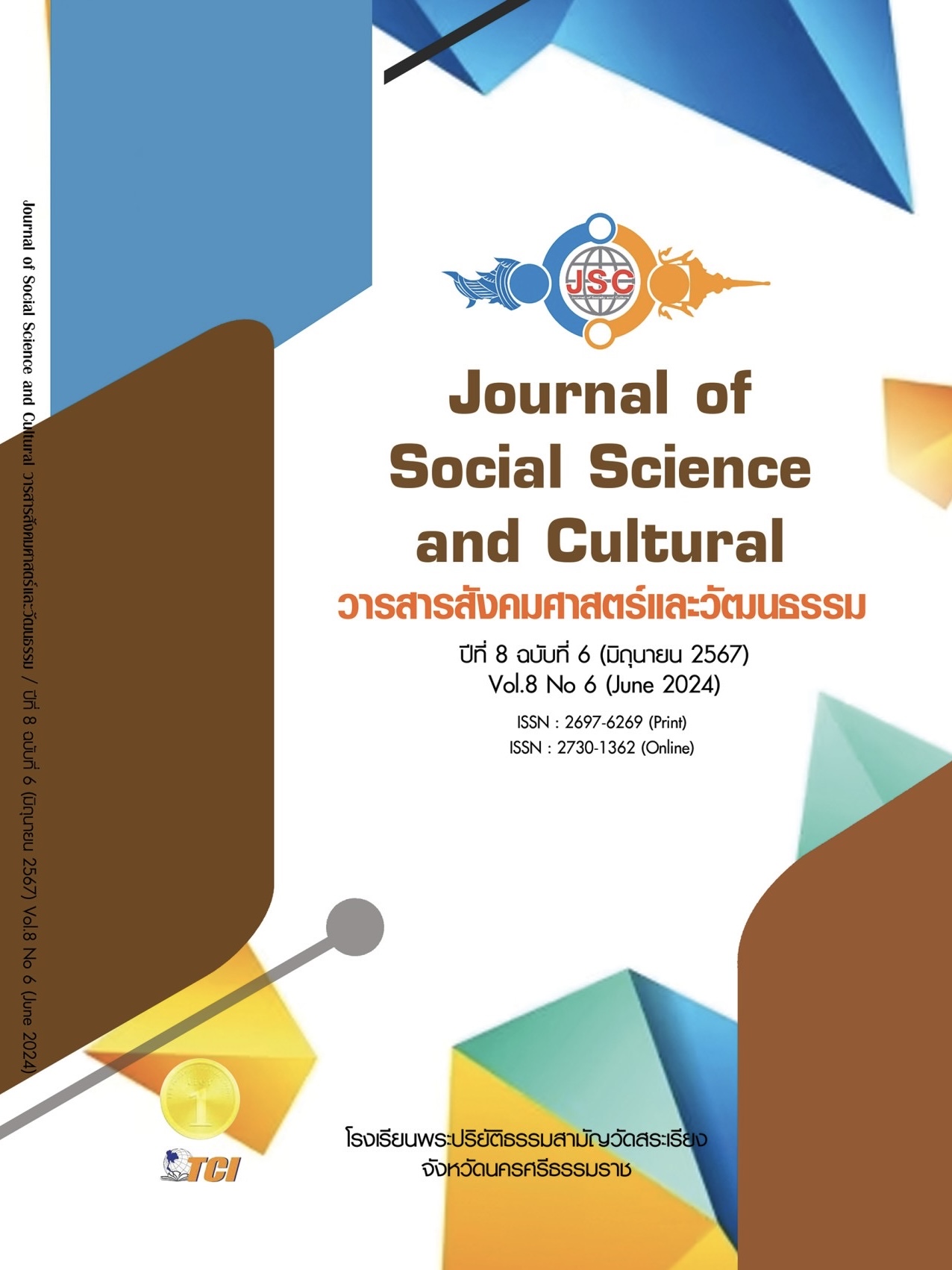ศึกษาองค์ประกอบการเล่าเรื่องที่มีเนื้อหาวิทยาศาสตร์ ในซีรีส์ Side by Side พี่น้องลูกขนไก่
Main Article Content
บทคัดย่อ
งานวิจัยนี้มีวัตถุประสงค์เพื่อศึกษาองค์ประกอบการเล่าเรื่องที่มีเนื้อหาวิทยาศาสตร์ในซีรีส์ Side by Side พี่น้องลูกขนไก่ โดยใช้วิธีวิจัยเชิงคุณภาพ การวิเคราะห์ข้อมูลใช้วิธีวิเคราะห์เนื้อหาจากสื่อประเภทละครขนาดยาวจำนวน 8 ตอน และบทสัมภาษณ์ของบุคคลที่เกี่ยวข้องโดยตรงกับเนื้อหาวิทยาศาสตร์ที่ปรากฎในซีรีส์ คือ ผู้เขียนบทละคร ผู้กำกับการแสดงและนักแสดงนำ โดยพบว่ามีการสอดแทรกเนื้อหาเกี่ยวกับวิทยาศาสตร์ประเด็น
ออทิสติกในทุกองค์ประกอบการเล่าเรื่อง ดังนี้ โครงเรื่อง เริ่มเรื่องแสดงให้เห็นความสัมพันธ์ของครอบครัวผู้มีสมาชิกเป็นผู้มีภาวะออทิสติก เดินเรื่องด้วยการพัฒนาความขัดแย้งที่แตกต่างกันของตัวละครหลักและการต่อสู้ระหว่างอุดมการณ์เกี่ยวกับออทิสติก มีภาวะวิกฤติ 2 ชุดต่อเนื่องจากความขัดแย้ง ภาวะคลี่คลาย ให้ข้อมูลเกี่ยวกับการดูแลผู้มีภาวะออทิสติจากผู้เชี่ยวชาญและแสดงผลลัพธ์ที่เกิดขึ้นในแง่บวก ยุติเรื่องราว การสร้างความอิ่มเอมใจหลังจากผู้มีภาวะออทิสติกต้องพบเจอกับบททดสอบและให้ผู้ชมได้ขบคิดถึงชีวิตของผู้มีภาวะออทิสติก แก่นเรื่อง
ชูเรื่องความสำคัญของความรักของคนในครอบครัวที่มีสมาชิกเป็นออทิสติก ความขัดแย้ง นำเสนอความขัดแย้งระหว่างคนกับคนและความขัดแย้งกับสังคมหรือกลุ่มคน ตัวละคร แสดงข้อมูลเบื้องต้นเกี่ยวกับภาวะออทิสติกที่ผู้ชมจดจำได้และข้อมูลกลุ่มอาการเฉพาะของ Asperger syndrome, บทสนทนา การใช้ภาษาที่เจืออารมณ์เพื่อสื่อสารเนื้อหาออทิสติก ฉาก ใช้เกณฑ์แบบแผนการดำเนินชีวิตของตัวละครออทิสติก และตอบจบ การจบแบบ
หักมุมและจบแบบปลายเปิดให้ผู้ชมได้ขบคิดถึงอนาคตผู้มีภาวะออทิสติก
Article Details
เอกสารอ้างอิง
กมลวรรณ กันยาประสิทธิ์. (2558). ประเด็นทางวิทยาศาสตร์กับสังคมเพื่อทักษะในศตวรรษที่ 21. วารสารศึกษาศาสตร์ มหาวิทยาลัยบูรพา, 2(26), 1-9.
ขจิตขวัญ กิจวิสาละ. (2564). ศาสตร์การเล่าเรื่องในสื่อสารศึกษา. วารสารศาสตร์, 14(3), 9-85.
จุฑามาศ สาคร. (2561). การสร้างตัวละครที่มีลักษณะเฉพาะและการเล่าเรื่องของละครโทรทัศน์ชุดโปรเจกต์ เอสเดอะ ซีรีส์ ตอน Side by Side พี่น้องลูกขนไก่ และ SOS Skate ซึม ซ่าส์. ใน วิทยานิพนธ์นิเทศศาสตรมหาบัณฑิต สาขาวิชานิเทศศาสตร. จุฬาลงกรณ์มหาวิทยาลัย.
เจณริฌา จงมี. (2559). การสื่อสารทางวิทยาศาสตร์. เรียกใช้เมื่อ 19 พฤศจิกายน 2567 จาก http://il258jenricha.blogspot.com/2016/03/blog-post_49.html.
ฐิตินันท์ ทองมาเอง. (2563). ความสัมพันธ์ระหว่างแรงจูงใจและการเปิดรับชมรายการสนามข่าว 7 สีทางโทรทัศน์ของผู้ชมในเขตกรุงเทพมหานคร. ใน นิเทศศาสตรมหาบัณฑิต สาขาวิชาการสื่อสารเชิงกลยุทธ. มหาวิทยาลัยกรุงเทพ.
ปณิสญา อธิจิตตา. (2555). การประกอบสร้างอุดมการณ์ทุนนิยมในละครโทรทัศน์ไทย. ใน วิทยานิพนธ์ศิลปศาสตรมหาบัณฑิต สาขาการสื่อสารศึกษา. มหาวิทยาลัยเชียงใหม่.
พรณรงค์ พงษ์กลาง. (2560). การบริหารจัดการสื่อโทรทัศน์ในศตวรรษที่ 21. วารสารสมาคมสถาบันอุดมศึกษาเอกชนแห่งประเทศไทย, 23(1), 90-101.
มาโนช รักไทยเจริญชีพ. (2560). พฤติกรรมการเปิดรับและปัจจัยที่ส่งผลต่อการเลือกเปิดรับชมโทรทัศน์ช่องข่าวในระบบดิจิทัลของประชาชนในเขตกรุงเทพมหานคร. วารสารสุทธิปริทัศน์, 31(98), 212-221.
ศวิตา ศีลตระกูล. (2563). การสร้างสรรค์ภาพยนตร์สารคดีสั้นที่มีเนื้อหาเกี่ยวกับผู้ที่มีภาวะดาวน์ซินโดรม. ใน วิทยานิพนธ์ศิลปศาสตรมหาบัณฑิต สาขาวิชาสื่อและนวัตกรรมการสื่อสาร. มหาวิทยาลัยศรีนครินทรวิโรฒ.
Dawson, E. (2013). What is science communication? Catalyst: Secondary Science Review, 24(1), 4-5.
ElShafie, J. S. (2018). Making Science Meaningful for Broad Audiences through Stories. Integrative and Comparative Biology, 58 (6), 1213-1223.
Sternsdorff, C. N. (2015). Food after Fukushima: Risk and scientific citizenship in Japan. American Anthropologist, 117(3), 455-467.


